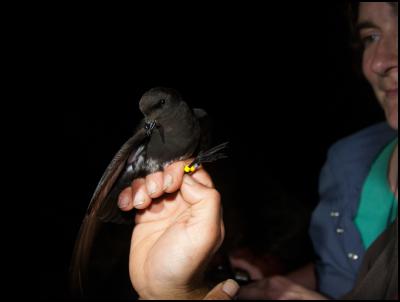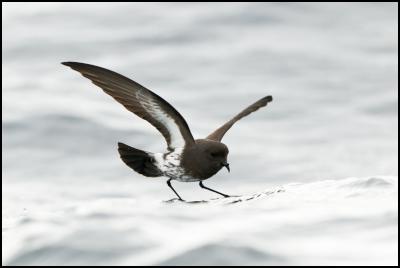“Extinct” seabird discovered breeding 50 km from Auckland
“Extinct” seabird discovered breeding 50 km from Auckland City
Researchers are elated to find the sparrow-sized New Zealand storm petrel, thought extinct until 2003, is breeding on Little Barrier Island Hauturu in the Hauraki Gulf Marine Park. The team of researchers is led by Chris Gaskin and Dr. Matt Rayner from the University of Auckland.

Bird in the hand, Dr Steffi
Ismar holds the first NZ storm petrel captured on land, 22
Feb 2013. Photo Martin Berg
The seabird is listed as
critically endangered by the International Union of the
Conservation of Nature and finding the breeding site is
vital for their conservation.
Three specimens of the diminutive 35g seabirds were collected off New Zealand in the 1800s and are held by museums overseas. Since its rediscovery, there has been speculation as to where this seabird breeds.
The team camped on the Poor Knights Islands, Mokohinau Islands and Little Barrier Island using radio receivers to zero in on the breeding site.
“It’s like looking for a needle in the haystack,” said Chris Gaskin. A critical breakthrough came last year when the project team found brood (incubation) patches on birds caught at sea. This determined the timing of incubation in New Zealand storm petrel, the best time to find breeding birds on land.
This year, 24 birds were caught at sea using specially designed net guns and small 1g radio transmitters were fitted to each bird. Automated receivers narrowed down the search. Team members, based at a remote camp on the north coast of the Little Barrier Island, using handheld receivers and spotlights, confirmed that birds were coming ashore under the cover of darkness and moving inland. This prompted moving the search area. Then, when a signal was picked up of a bird stationary in forest at night, team members were able to get a clear fix on where that site was.
Dr. Rayner says: “The site being monitored is very fragile and with birds at a delicate stage in their breeding cycle. We are using automated equipment for the most part and maintaining a hands-off approach, although team members visiting the vicinity have also been keeping watch.”
“On Friday morning a bird was discovered on the ground, possibly having just left its burrow. At the same time team members detected another bird, this one most probably on a nest,” said Chris Gaskin. “It’s an amazing result for our enthusiastic and dedicated team.”
Members of the research team will remain on the island over the coming weeks. Aerial surveys are also being used to try and establish the distribution and size of the population.
The Hauraki Gulf Forum is about to publish a Hauraki Gulf seabird management strategy and research plan drawing on the work of Chris Gaskin and Dr. Rayner and New Zealand and international collaborators.
Chair of the Hauraki Gulf Forum, John Tregidga, said locating the breeding ground was internationally significant and further highlighted the importance of the Hauraki Gulf Marine Park as a globally significant biodiversity hotspot.
Dr Rayner, a Little Barrier Island trustee, said the discovery reiterated the importance of careful management of conservation jewels, such as Little Barrier Island and surrounding marine environments.
The project has been funded this year by grants from Mohammed bin Zayed Species Conservation Fund, Birdlife International Community Conservation Fund, The Little Barrier Island Hauturu Supporters Trust and ASB Trust, Auckland Council, Forest & Bird Central Auckland Branch and Peter Harrison/Zegrahm Expeditions, with further support from the Department of Conservation, Hauraki Gulf Forum and Landcare Research.

NZ Storm Petrel Photo credit
Neil Fitzgerald Photography
ENDS


 Gordon Campbell: On Our Austerity Fixation And Canada Staying Centre-left
Gordon Campbell: On Our Austerity Fixation And Canada Staying Centre-left Unions Otago: May Day Workers' Hui
Unions Otago: May Day Workers' Hui People Against Prisons Aotearoa: Voting Ban “Undermines Democratic Principles” Says Justice Group
People Against Prisons Aotearoa: Voting Ban “Undermines Democratic Principles” Says Justice Group Taxpayers' Union: Nationwide Hīkoi Calling For Balanced Budgets
Taxpayers' Union: Nationwide Hīkoi Calling For Balanced Budgets Greenpeace: Luxon’s War On Nature Opens Gate For More Dairy Conversion
Greenpeace: Luxon’s War On Nature Opens Gate For More Dairy Conversion NZ Labour Party: Consenting Change Opens Door For Cowboys
NZ Labour Party: Consenting Change Opens Door For Cowboys New Zealand Government: Accelerating The Roll-Out Of Public EV Chargers
New Zealand Government: Accelerating The Roll-Out Of Public EV Chargers


